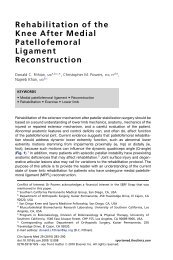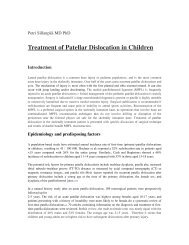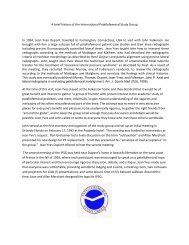Patellar Instability (West and Colvin) - The Patellofemoral Foundation
Patellar Instability (West and Colvin) - The Patellofemoral Foundation
Patellar Instability (West and Colvin) - The Patellofemoral Foundation
You also want an ePaper? Increase the reach of your titles
YUMPU automatically turns print PDFs into web optimized ePapers that Google loves.
NUMBERD2759dTHE J OURNAL OF B ONE &JOINT S URGERY JBJS. ORGd dVOLUME 90-A 12 ECEMBER 2008PATELLAR I NSTABILITYTABLE I Grades of Recommendation for Summaries or Review ofOrthopaedic Surgical StudiesGradeABCIDescriptionGood evidence (Level-I studies with consistentfindings) for or against recommending intervention.Fair evidence (Level-II or III studies with consistentfindings) for or against recommending intervention.Poor-quality evidence (Level-IV or V studies withconsistent findings) for or against recommendingintervention.<strong>The</strong>re is insufficient or conflicting evidence notallowing a recommendation for or againstintervention.lateral <strong>and</strong> central areas of the trochlea 88 . However, pressures areelevated on the medial aspect of the trochlea <strong>and</strong> the proximalmedialaspect of the patella at all flexion angles, <strong>and</strong> thus cautionshould be used when performing an anteromedialization procedurein patients with medial-sided defects 88 .Buuck <strong>and</strong> Fulkerson reviewed their results with anteromedializationat an average of 8.2 years postoperatively 81 .<strong>The</strong>ir indications for the procedure were painful patellofemoralmaltracking (subluxation or tilt) with degenerativechanges on the distal <strong>and</strong> lateral aspects of the patella. Poorerresults were associated with Outerbridge 91 grade-3 or 4 lesionsin the central or medial aspects of the trochlea. Notably, threeof the six fair or poor results were in patients who had compensationclaims or were involved in litigation. Overall, 74%(thirty-one) of the forty-two patients had a good or excellentresult at an average of 8.2 years postoperatively.Pritsch et al. reported their results of tibial tubercle transferfor treatment of recurrent patellar instability, anterior knee pain,<strong>and</strong> evidence of maltracking on a dynamic computed tomographyscan 85 . Sixty-nine knees followed for a median of 6.2 yearshad a significant improvement between the preoperative <strong>and</strong>postoperative Lysholm <strong>and</strong> Gillquist 77 <strong>and</strong> Karlsson 92 score categoriesof instability, pain, <strong>and</strong> stair-climbing (p < 0.001).However, patients who had had only instability preoperativelydid better than patients with pain or both pain <strong>and</strong> instabilitypreoperatively. A better outcome was correlated with male sex,intact patellar articular cartilage, <strong>and</strong> symptoms of patellar instability.Physical examination findings that correlated with aworse prognosis included a positive patellar grind test, retinacularpain, a positive patellar tilt test, <strong>and</strong> a positive J-sign. <strong>The</strong>duration of follow-up was also positively correlated with betterLysholm <strong>and</strong> Gillquist 77 <strong>and</strong> Karlsson 92 scores, which the authorsattributed to the need for quadriceps recovery in the short term.Furthermore, there was no deterioration of the results with time.Pidoriano et al. found that the location of articular cartilagedamage in the patellofemoral joint correlated with the outcomeafter anteromedialization 80 . Of thirty-six patients (thirty-sevenknees), 56% (twenty) had the procedure performed because ofpatellar instability. All twenty-three patients with distal <strong>and</strong>lateral patellar lesions were extremely satisfied with the result ofthe procedure. <strong>The</strong>re was a 95% rate of good-to-excellent results(if no Workers’ Compensation claim was involved), <strong>and</strong> 87%had good-to-excellent pain relief. <strong>The</strong> authors recommendednot proceeding with the operation if medial, proximal, or diffuselesions were present on the patella or if central lesions werepresent on the trochlea. Interestingly, the Outerbridge 91 classificationof the lesion had no effect on the outcome.Palmer et al. also reported satisfactory results after anteromedializationfor treatment of both instability <strong>and</strong> painfulpatellar maltracking 84 . In a study of eighty-four patients followedfor a mean of 5.6 years, the result was good to excellent in 80% ofpatients with dislocation <strong>and</strong> 71% of patients with pain frommaltracking. <strong>The</strong>re was no significant difference in outcomebetween the groups, leading the authors to recommend anteromedializationof the tibial tubercle with distalization as aneffective procedure for both instability <strong>and</strong> pain due to maltracking.Predictors of poor postoperative results were postoperativeanterior knee pain <strong>and</strong> a previous realignment procedure.Fracture of the proximal part of the tibia or of the tibialtubercle after tibial tubercle transfer has been reported by severalauthors 86,93,94 . All cases occurred within three months after theoperation <strong>and</strong> were attributed to early weight-bearing. Suggestedpreventive measures have included avoidance of step cuts 86 ,anosteotomy of at least 5 cm in length <strong>and</strong> 0.75 cm in thickness toavoid fracture of the tuberosity 86 , protected weight-bearing oversix to eight weeks in a hinged knee brace, <strong>and</strong> advancement tofull weight-bearing once the osteotomy site is fully healed 93-95 .Overview<strong>The</strong> evaluation <strong>and</strong> treatment of patellar instability continue toevolve. <strong>The</strong> importance of a thorough physical examination <strong>and</strong>an accurate diagnosis cannot be stressed enough. We typicallyTABLE II Grades of Recommendation for the Treatment of Acute <strong>Patellar</strong> Dislocation <strong>and</strong> Chronic <strong>Patellar</strong> <strong>Instability</strong> with Associated FactorsDisorder Treatment Grade of RecommendationAcute patellar dislocation Early medial-sided repair or nonoperative treatment AChronic patellar instability with associated factorsPatella alta Tibial tubercle realignment CMedial patellofemoral ligament injury Medial patellofemoral ligament reconstruction CTrochlear dysplasia Trochleoplasty CElevated tibial tubercle-to-trochlear groove distance Tibial tubercle realignment C






